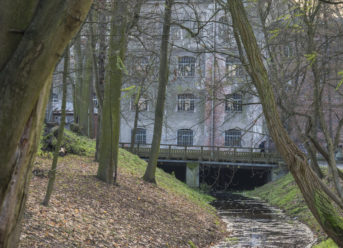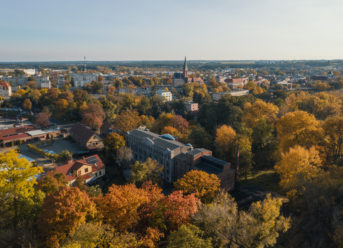Młyn Dahlmanna
Die Dahlmann-Mühle
Dahlmann
Legenda głosi, że pierwszy młyn wodny na rzece Wełnie zbudowany został na konarze drzewa, a pierwsze historyczne wzmianki znajdujemy już w XV wieku. W źródłach pojawia się pod nazwą Słonawy Młyn, obejmując poza budynkiem osadę młyńską, nazywaną również obszarem dworskim, który jeszcze w 1920 r. leżał poza granicami naszego miasta. Władze już w XIX w. czyniły starania o połączenie z miastem, jednak dopiero w roku 1926 udało się to pozytywnie przeprowadzić. W pierwszej połowie XVIII wieku własność ta należała do rodziny Hermanów, która sprzedała staroście obornickiemu, a ten w 1749 r. odsprzedał małżonkom Busse.
Sytuacja zmieniła się po II rozbiorze Polski (1793) – przyłączeniu tych ziem do Prus, szczególnie po zaostrzeniu się polityki germanizacyjnej. Magistrat starał się o przyłączenie tego terenu do miasta, jednak ówczesne władze niemieckie starania te odrzucały. W 1884 r. obszar ostatecznie został usamodzielniony i stan ten trwał do 1926 r. Po odzyskaniu niepodległości, po I wojnie światowej, właścicielami tych dóbr byli: Wilhelminna Dahlmann i dr Klaus Dahlmann.
Rodzina Dahlmannów, obiekt ten rozbudowała najokazalej. W 1884 r. zbudowała tutaj nowy młyn zbożowy na fundamentach poprzednika. Młyn Dahlmanna na ówczesne czasy był bardzo nowoczesny. Jako pierwszy w mieście miał własne źródło prądu. Dostarczał go później do oddanego do użytku 1 stycznia 1938 r. budynku Ubezpieczalni Społecznej (aktualnie budynek Urzędu Miejskiego) i Szpitala Miejskiego w Obornikach.
Po II wojnie światowej młyn upaństwowiono i włączono do przedsiębiorstwa Państwowych Zakładów Zbożowych w Szamotułach, które zarządzały nim do swojej upadłości w latach 90. XX w. Dziś młyn pozostaje w rękach prywatnych, a właściciel wkrótce zamierza przeprowadzić rewitalizację zarówno samego gmachu, jak i urokliwego terenu wokół.
Weit zurück in die Vergangenheit reichen die Wurzeln der Wassermühle am Fluss Wełna. Der Legende nach sollte die ursprüngliche Mühle auf einem Ast erbaut werden sein.
Die erste Erwähnung über die Mühle stammt aus dem 15. Jh.. Ursprünglich wurde das Bauwerk „Słonawy-Mühle“ genannt, es befand sich nämlich im Gebiet eines der Stadt Oborniki benachbarten Dorfes Słonawy. Nach Quellen war die Słonawy-Mühle ein groβer Gebäudekomplex, welcher auch als ein Hof bezeichnet wurde. Erst im Jahre 1926 wurde das Dorf Słonawy an die Stadt Oborniki angeschlossen.
In der ersten Hälfte des 18. Jhs. gehörte die Wassermühle der Familie Herman. Danach ging sie an das Landratsamt. Im Jahre 1749 übernahm die Familie Busse den Betrieb. Nach der zweiten Teilung Polens (1793) wurde das Gebiet dem Preußischen Teilungsgebiet einverleibt und die Mühle von der preußischen Verwaltung übernommen. In der zweiten Hälfte des 19. Jhs. erwarb die Familie Dahlman den Mühle-Komplex. Der Familie Dahlmann ist dessen umfangreichste Ausbeutung zu verdanken. In seiner jetzigen Form wurde das Mühlgebäude 1884 errichtet – auf den Fundamenten des ursprünglichen Bauwerkes wurde ein neues gemauertes Gebäude aufgebaut.
Auch nach der Wiedererlangung der Unabhängigkeit Polens (1918) war die Mühle im Besitz von Wilhelmina Dahlmann und Dr Klaus Dahlmann. Sie wurde grundlegend modernisiert - als erstes Gebäude in der Stadt wurde der Mühle-Komplex in Strom versorgt. Die Mühle konnte durch Wasserkraft den Strom erzeugen und endgültig losgelöst von der Natur arbeiten. Auch das im Jahre 1938 gegründete lokale Gesundheitszentrum für medizinische Grundversorgung (Ubezpieczalnia Społeczna) - das heutige Gebäude der Gemeindeverwaltung und das städtische Krankenhaus (Szpital Miejski) wurden mit dem durch die Mühle erzeugten Strom versorgt.
Nach dem Zweiten Weltkrieg wurde die Mühle verstaatlicht und dem Szamotuły - Getreidebetrieb (Państwowe Zakłady Zbożowe w Szamotułach) einverleibt. Anfang der 90-er Jahren wurde der nicht mehr rentable Betrieb stillgelegt. Heute ist die Mühle im Privatbesitz. Ein der Mühlgebäuden wurde vor Kurzem originalgetreu renoviert. Der Besitzer hat vor, in nächsten Jahren den Mühle-Komplex und die umliegende Landschaft zu revitalisieren.
Legend has it that the first watermill on the Welna River was built on a tree branch, and the first historical references can be found as early as in the 15th century. In the sources it appears under the name of Słonawy Młyn (Slonawy Mill), covering the outside of the building there is a mill settlement, also known as the manor area, which was still outside the borders of town Oborniki in 1920. The authorities made efforts to connect it with the town as early as in the 19th century, however, it was not until 1926 that it was successfully merged. In the first half of the 18th century, the property belonged to the Herman family, which sold it to the obornicki district administrator, and in 1749 it was sold to the Busse family. The situation changed after the Second Partition of Poland (1793) and the annexation of these lands to Prussia, especially after the tightening of the Germanization policy. The municipal authorities tried to annex this land to the city, but the German authorities of that time rejected these efforts. In 1884, the area was independent and the state lasted until 1926. After regaining independence, after World War I, the owners of these estates were: Wilhelminna Dahlmann and Dr. Klaus Dahlmann. The Dahlmann family, has greatly expanded the facility. In 1884 they built a new grain mill on the foundations of the old one. The Dahlmann mill was very modern at that time. It was the first in the city to have its own power supply. Electricity was later supplied to the Social Insurance Institution building (currently the Municipal Office building) and the Municipal Hospital in Oborniki, which was opened on 1 January 1938. After the Second World War, the mill was nationalized and incorporated into the enterprise of the State Grain Factory in Szamotuły, which managed it until its bankruptcy in the 1990s. Today the mill remains in private hands and the owner soon intends to revitalize both the building itself and the charming surrounding area.





